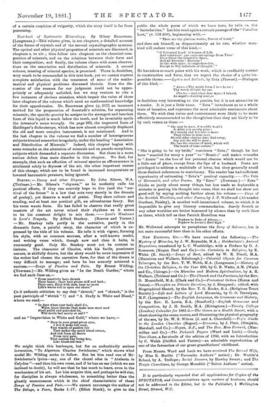Text-book of Systematic Mineralogy. By Hilary Bauerman. .(Longmans.)—This volume gives,
in ten chapters, a detailed account of the forms of crystals and of the several crystallographic systems. The optical and other physical properties of minerals are discussed, in chapters x. to xiv. ; then follow two chapters on the chemical com- position of minerals, and on the relations between their form and their composition; and finally, the volume closes with some observa- tions on the association and distribution_ of minerals. A second volume, treating of mineral species, is promised. There is, doubtless, very much to be commended in this text-book, yet we cannot express complete satisfaction with the treatment of some of the mathe- matical and physical problems discussed therein. Here the dis- cussion of the reasons for our judgment could not be appro- priately or adequately unfolded, but we may venture to cite a few instances of obvious mistakes, which impair the value of those later chapters of the volume which need no mathematical knowledge for their apprehension. Mr. Bauerman gives (p. 217) an incorrect method for the preparation of Sonstadt's solution, for separating minerals; the specific gravity he assigns to the strongest and heaviest form of this liquid is much below the truth, and be invariably spells the inventor's name wrongly. On page 285, the improved form of Haidinger's dichroiscope, which has now almost completely displaced the old and more complex instrument, is not mentioned. And in the last chapter in the volume we find a number of heterogeneous subjects treated somewhat irregularly, ander the heading "Association and Distribution of Minerals." Indeed, this chapter begins with some remarks on the alteration of minerals and on pseudo-morphism, subjects which demanded a separate discussion. But there is a more serious defect than mere disorder in this chapter. Wo find, for example, that such an affection of mineral species as efflorescence is attributed solely to dryness of the air, the other important causes of this change, which are to be found in increased temperature or lowered barometric pressure, being ignored.






































 Previous page
Previous page